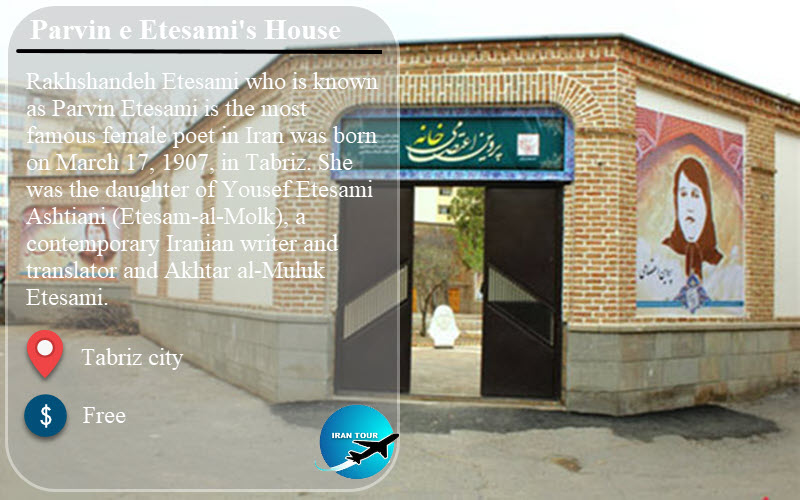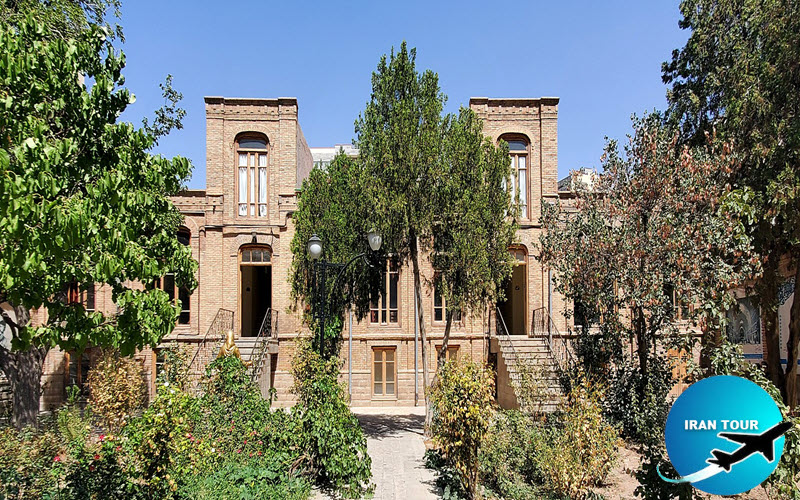Copyright 2020 - 2021 irantour.tours all right reserved
Designed by Behsazanhost
Parvin e Etesami's House, the most renowned Iranian female poet
Parvin e Etesami's House, the most renowned Iranian female poet
If you are a literary tourist or interested in Iranian literature and poetry, the city of Tabriz in the west of Iran is one of the best tourist destinations, like Shiraz( the city of great poets Saadi & Hafez). Great and famous poets of Iran, such as Shahryar and Mrs. Parvin Etisami, the most famous Iranian female poets, were from Tabriz. The old house of Parvin Etesami in Tabriz is changed into a museum to show the history and life of Parvin Etesami as the most famous and renowned Iranian female poet.
 |
This literary museum is a nice tourist destination to attract those with cultural and poem enthusiasm. She was the daughter of a journalist and was born on March 16, 1907, in a house located in Sheshkalan a district in the city center of Tabriz and passed away on April 5, 1941. Her first collection of poetry (Divan) was published while she was still alive. However, the release of her second divan coincided with her sudden death. Overall, Parvin had over 606 poems of various lengths and compositions of Persian poetry like Qasideh, Qazal, etc.
Parvin’s house or museum in Tabriz is a two-story edifice located in an alley named after her and is belong to the Pahlavi era(circa 1900). The 1,300 square meter house also served as a permanent museum ground to showcase the crafts and cultural heritage of East Azerbaijan province.
How to visit Tabriz in one day |
 |
Discover Parvin Etesami; Shining Jewel in Persian Literature's history
1. PARVIN ETESAMI the daughter of a journalist by the name of YUSOF ETESAMI. She was born in Tabriz and moved to Tehran in her early life.
2. She refused to work in governmental and political offices. In 1926, he was invited to teach the queen of the new Pahlavi court, and in 1936, the Ministry of Education honored him with a third-class medal, but he refused to accept all of them.
3. With the encouragement and help of his father, his literary talent appeared at the age of 7 or 8. His first known poem, consisting of 11 poems, was published in his father's monthly magazine (Spring Magazine) in 1921. His first divan consisting of 156 poems was published in 1935.
4. His father's death in 1938 deprived Parvin of his loving support and virtually severed his contact with the outside world. She died only three years after her father's death. She was buried near her father in Qom city and the shrine of Hazrat e Masoomeh.
5. PARVIN's poetry follows traditional patterns in both form and substance. In the protective isolation of her family life, she was unaffected by the ongoing reformist trends in Persian poetry or perhaps was even unaware of them. In the arrangement of his couch, there are 42 untitled qaṣidas, and qeṭʿas, mostly didactic and philosophical reminiscent of the austere tone of Naṣer-e Ḵosrow and Sanai.
There are several other qaṣidas scattered throughout the collection, especially in the description of nature, which rely heavily on Manuchehri. Parvin did not indulge in lyricism. Shy by nature and isolated by traditional standards of conduct, she never expressed inhibited feelings of love and desire. His couch leaves little room for gazals. Nevertheless, several poems, including five entitled "Arzuha" (Desires), are perfect examples of lyrics. "Safar-e ask" (Journey of a tear) is one of the most beautiful lyrics ever written in Persian.
6. She does not comment on political issues and events of his time (1921-1941) and the only exception is about the veiling of women in 1935. However, she has many references to the problems and poverty of the masses in his poems. Lack of social justice, poverty, and social suffering are among the most important points in his poems.
7. Parvin often used animate and inanimate creatures that clutter his parables and confrontational poems to express his feelings of dissatisfaction and social protest without arousing political suspicion.
- Details
- Category: Museums of Tabriz